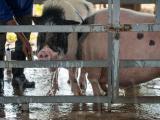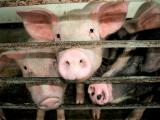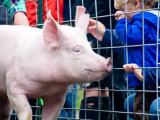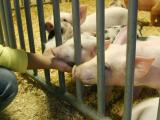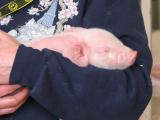Editor's Note: The following story as originally published had an error in stating that the live animal market the affected family had visited was at the "Dakota County fair." As corrected below, the market was in Dakota County but not within a fair setting.
Aug 20, 2012 (CIDRAP News) – Minnesota health officials today reported the state's first cases of the novel H3N2 flu mainly linked to contact with pigs at agricultural fairs. And with cases of H3N2v climbing across the nation, the US Centers for Disease Control and Prevention (CDC) recently urged schools to be on the lookout for infections.
The Minnesota Department of Health (MDH) said in a statement today that it has confirmed one H3N2v case in a preschool-aged child and a probable infection in an older sibling. The children, who live in the Twin Cities metropolitan area, got sick 2 days after their family visited a live animal market in Dakota County on Aug 10. The MDH said both children were most likely exposed to the virus at the animal market.
Though both children were tested, the result was positive only for the younger child, but the MDH said it considers the older sibling a probable case, based on the history of flulike illness and the family connection to the younger child. Neither child has been hospitalized, and both are recovering. The MDH said no further spread of the virus from the children to other people has been detected.
Minnesota officials aren't discouraging people from going to live markets or attending fairs, such as the Minnesota State Fair, which begins on Aug 23. However, it is stepping up surveillance for the disease and is urging fairgoers and exhibitors to take precautions, such as washing hands with soap and running water after exposure to animals. They also urged people with flu symptoms to avoid contact with pigs, since the virus can also be transmitted from humans to pigs. The MDH urged sick exhibitors and others who can't avoid contact with pigs to wear protective clothing such as gloves and masks.
The MDH said the Minnesota Board of Animal Health is encouraging pork producers to observe good biosecurity practices, and it emphasized that the new virus doesn't pose a food safety risk.
Elsewhere, Ohio officials are reporting 79 infections with the new strain, an increase of seven from the previous week, the Associated Press (AP) reported on Aug 18. The addition of Ohio's seven latest cases and the two cases from Minnesota would push the nation's number of H3N2v cases to 239 cases in 10 states.
In other developments, the CDC on Aug 17 said no school outbreaks have been reported of the H3N2v viral infection. The H3N2v contains the matrix gene from the 2009 H1N1 virus, which the CDC said might allow it to spread more easily among humans.
Though the risk seems to be mainly limited to pig exposure, some person-to-person transmission has been identified with the virus before and may crop up again, the CDC said in its guidance for schools.
Schools can play a key role in identifying suspected H3N2v infections and helping to slow the spread of the virus, the CDC said. It urged schools to ask students who have flulike symptoms if they recently had direct contact with pigs or close contact with a person who has been near pigs, especially in states where H3N2v cases have already been detected. Local health departments should be notified about sick students with a history of direct or indirect contact with pigs so that children can be tested for H3N2v infection.
To curb the spread of H3N2v and any flu virus, the CDC urged schools to refer students who have flulike symptoms and are at high risk for complications, such as those with asthma and other chronic conditions, to healthcare providers regardless of whether they have recently been exposed to pigs. It also recommended encouraging sick students and staff to stay home until their symptoms subside and to practice routine precautions, such as covering coughs and sneezes and practicing good hand hygiene.
In a separate update on the new virus, the CDC shared some information on surveillance on swine testing for flu viruses. It said when H3N2 viruses that contain the 2009 H1N1 pandemic matrix gene turn up in swine, they are called H3N2pM. It said further that testing from the US Department of Agriculture (USDA) and its partners first found the H2N2pM virus in isolates collected in late 2010 and that the virus has turned up in sampling ever since.
Of 138 H3N2 samples identified from Oct 1, 2011, through Jul 31, 2012, 57 contained the pandemic M gene and were classified as H3N2pM, the CDC said in an Aug 17 statement. It added that several more H3N2 isolates are undergoing more advanced testing to characterize the virus.
Last week, a group from the CDC and several universities reported that pigs testing positive for the H3N2pM virus often show no symptoms, which makes it more difficult for fair organizers and other authorities to visually flag sick animals as part of their efforts to control the spread of the virus to people and other pigs.
See also:
Aug 20 MDH statement
Aug 18 AP story
Aug 17 CDC update
Aug 17 CDC supplemental H3N2v guidance for school administrators
